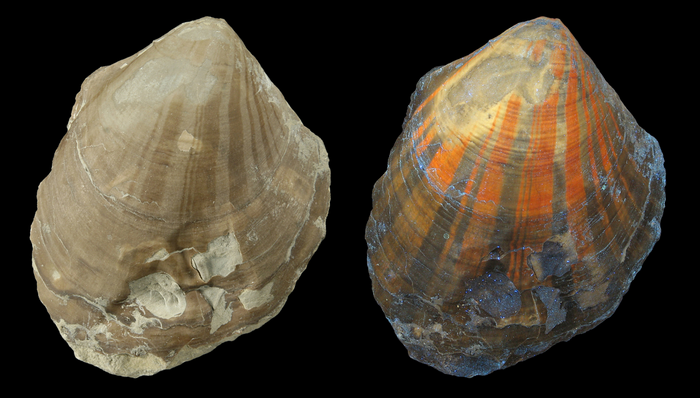UV light makes it possible to see intricate structures of fossils that are barely visible in normal daylight. This method has often been used on the fossilised seashells from the Earth’s current geological era to reveal patterns of colour that had long since faded away. Now, research by a scientist from the University of Göttingen shows that fluorescent colour patterns can even be found in shells that are around 240 million years old, from the Earth’s Mesozoic Era. This makes them the oldest fluorescent colour patterns found so far. The results of this study have been published in the journal Palaeontology.

Credit: Klaus Wolkenstein
UV light makes it possible to see intricate structures of fossils that are barely visible in normal daylight. This method has often been used on the fossilised seashells from the Earth’s current geological era to reveal patterns of colour that had long since faded away. Now, research by a scientist from the University of Göttingen shows that fluorescent colour patterns can even be found in shells that are around 240 million years old, from the Earth’s Mesozoic Era. This makes them the oldest fluorescent colour patterns found so far. The results of this study have been published in the journal Palaeontology.
In fossils from the Mesozoic Era, traces of colour patterns are very rarely observed. However, the investigation with UV light of scallops from the Triassic period – right from the beginning of the Mesozoic Era – shows that colour patterns are preserved much more frequently than previously thought. UV light, which is invisible to the human eye, excites organic compounds in the fossils causing them to glow. This reveals a surprising variety of colour patterns: different variations of stripes, zigzags and flame patterns. The diversity of colour patterns is similar to those of today’s seashells found on a beach.
However, the colour patterns of today’s scallops do not show any fluorescence. “In the case of the Triassic shells, fluorescent compounds were only formed in the course of fossilisation through oxidation of the original pigments,” explains Dr Klaus Wolkenstein from the Geosciences Centre at the University of Göttingen, who is currently carrying out research at the University of Bonn. Surprisingly, the fossil shells show different fluorescent colours, depending on the region where they were found. “The colour spectrum ranges from yellow to red with all the transitions in between, which suggests that there were clear regional differences in the fossilisation of these scallops,” adds Wolkenstein.
Original publication: Wolkenstein, K. (2022): Fluorescent colour patterns in the basal pectinid Pleuronectites from the Middle Triassic of Central Europe: origin, fate and taxonomic implications of fluorescence. Palaeontology. doi: 10.1111/pala.12625
Contact:
Dr Klaus Wolkenstein
University of Göttingen
Geoscience Center – Geobiology Department
Goldschmidtstraße 3, 37077 Göttingen, Germany
Tel: +49 (0)551-39-7960
Email: [email protected]
Journal
Palaeontology
DOI
10.1111/pala.12625
Method of Research
Observational study
Subject of Research
Not applicable
Article Title
Fluorescent colour patterns in the basal pectinid Pleuronectites from the Middle Triassic of Central Europe: origin, fate and taxonomic implications of fluorescence
Article Publication Date
27-Sep-2022




